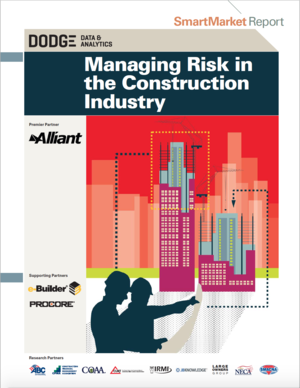
Even with the continued proliferation of collaborative tools and delivery methods, construction remains a risky business, according to “Managing Risk in the Construction Industry,” a study undertaken by Dodge Data & Analytics. A key finding of the report: “Collaboration is widely recognized as beneficial in an industry still plagued by silos and competition within teams.”
The results—or lack thereof—speak for themselves. The freely downloadable study, performed in partnership with Alliant Insurance Services Inc., with support from e-Builder and Procore, found a staggering three-quarters of 500 owners and contractors surveyed have experienced a dispute claim in the past five years. The problem is pervasive among project types ranging from commercial, institutional, and industrial buildings to horizontal infrastructure, all represented in the study. “Owners feel the greatest impact from planning/scope changes, schedule changes, and cost escalation,” the study states. “GCs and trade contractors are more concerned about labor procurement and contractual risks, from how risk is apportioned directly by the contracts to issues like warranties, guarantees, etc.”
Survey respondents indicated top risk factors include labor procurement risks/subcontract management (27%), schedule changes (26%), contractual specification of risk (24%), planning/scope changes (21%), and contractual risks (21%).

However, the study detects a distinct correlation between risk reduction and collaboration among project team members. “The two top strategies for all respondents—formal brainstorming with the team and regular project meetings with the full team focused on risk—enhance collaboration across teams and yield critical benefits like increasing reliability in overall project performance, reducing the cost of construction, improving project schedule, and improving safety,” the study states.
In all, 91 percent of survey respondents indicated that collaboration reduces risk. Further, respondents placed significant value on “project delivery methods that encourage greater team integration as a means to drive the expanded future use of risk-management practices,” according to the the study.

“Early collaboration by team members can lead directly to less project risk and crisis—a significant incentive to start working together better, more often,” suggested Steve Jones, Dodge’s senior director of industry insights research.
“The concept of collaboration and integration is not new and has been around for decades,” Karen Walsh, senior vice president and regional director of Alliant, said in a statement. “The difference today is with the preponderance of large-scale mega projects, this becomes a new reality with much higher stakes for all sides. Regardless of the disposition, each party’s risk concentration is exacerbated. Couple this with the emerging and still unknown complications of technological, political, and workplace violence risks, and you have a situation that forces the concept for change for all parties.”
The study addresses five key topics relating to risk management: exposure to risk on past projects, high risk factors, evaluation and mitigation strategies for risk, triggers and obstacles for increased use of risk management practices, and impact of industry trends and practices on risk.
It also includes an extensive case study involving the implementation of risk management for the redevelopment of Kings Theatre in Brooklyn, NY, and “Perspectives of a Lean Superintendent,” by Neal Ernest, general superintendent with Balfour Beatty Construction.
“THE CONCEPT OF COLLABORATION IS NOT NEW. … THE DIFFERENCE TODAY IS WITH THE PREPONDERANCE OF LARGE-SCALE MEGA PROJECTS, THIS BECOMES A NEW REALITY WITH MUCH HIGHER STAKES.”
For the $95 million restoration of Kings Theatre, originally completed in 1929, project construction manager Gilbane Building Co. implemented a risk-assessment template that allowed project leaders to analyze and rate each of 12 risk categories, each containing two or three subsections, and calculate a weighted score for the project. “But it’s not about the score,” Sue Klawans, Gilbane senior vice president and director of operational excellence and planning, said in the case study. “The real value is in the conversation.” The template provided an agenda for project leaders to develop strategies for success, a process described by Klawans as “swarm and solve.”


Discussion
Be the first to leave a comment.
You must be a member of the BuiltWorlds community to join the discussion.